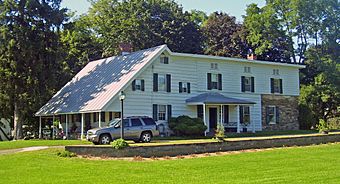Van Rensselaer Lower Manor House facts for kids
Quick facts for kids |
|
|
Van Rensselaer Lower Manor
|
|

South elevation and east profile, 2008
|
|
| Location | Claverack, NY |
|---|---|
| Nearest city | Hudson |
| Area | 1.3 acres (0.53 ha) |
| Built | 1715–90 |
| Architectural style | Colonial |
| MPS | The Architectural and Historic Resources of the Hamlet of Claverack, Columbia County, New York |
| NRHP reference No. | 97001615 |
| Added to NRHP | January 7, 1998 |
The Van Rensselaer Lower Manor is a very old and interesting house in Claverack, New York. It's located along New York State Route 23. This house is actually a mix of two different homes built in the 1700s. One part is made of stone, and the other is a wooden frame house.
Over time, these two houses were connected and then covered with wood siding to look like one big building. Even though one historian thought it looked like a "growth" because of all the changes, it still has many of its original rooms and windows inside. This house was important because the Van Rensselaer family used it to manage their large land areas during the time when America was still a colony. In 1998, the house and its old barn were added to the National Register of Historic Places, which means they are recognized as important historical sites.
Contents
About the Property
The Van Rensselaer Lower Manor sits on a 1.3-acre (0.53 ha) piece of land. This land is on the north side of Route 23, about 0.8 miles (1.3 km) east of the center of Claverack. The ground gently slopes up to the house from the front.
There's an old barn just north of the house. There's also a greenhouse and shop to the southeast. A dirt driveway runs along the east side of the house, leading to the barn.
The House Itself
The house is a two-story building. It looks like one long house from the front. The front part of the roof is made of metal and slopes up. It has two brick chimneys. The house is covered in white wooden siding, called clapboard. You can still see some of the original stone walls at the back of the first floor. The front part of the house also has a basement.
A newer, one-story kitchen area has been added to the west side of the house. All the windows have wooden shutters with slats. Small vents are above the second-story windows. On the east side of the house, there's an entrance with a porch that has a sloped roof.
Inside the Manor
When you enter the main door under the front porch, you step into a small entry area. This area opens into two living rooms, one on each side. Both rooms have a large fireplace with their original decorative covers. There's also a finely carved wooden rail around the bottom part of the walls in these rooms. In the kitchen area, you can see some of the old bricks from when the house was first built.
The entrance to the middle part of the house, by the east porch, has windows on the sides of the door. This door opens into a hallway that goes from the front to the back of the house. There's an old doorway that used to connect the middle part to the very first house at the back. This old door has a special carved design above it. The oldest rooms in the house still have their original fireplace and a special oven for baking. There's even an iron kettle built into the chimney. One room appears to have been used for smoking food because its plaster is smudged.
Other Buildings
The barn is located just north of the house. It's made of wood and has a metal roof. It also has a newer, small addition. There's a root cellar in one corner, which is a cool, dark place for storing food. This barn is considered an important part of the historic property.
There's also a greenhouse and flower shop near Route 23. This building is newer, so it's not considered part of the original historic property.
History of the Manor
People used to think the first house on this spot was built in 1685. That was when the English government gave the Van Rensselaer family special rights to their land. Before that, under Dutch rule, the family were called patroons, which meant they were like powerful landlords.
Later research showed the first house was actually built in 1715. It was built by Samuel ten Broeck and his wife Catherine van Rensselaer. Catherine's father had inherited this part of the family's land. The house was used to collect rent from farmers and manage other family business. The family would split their time between this house and Albany.
Changes Over Time
The Van Rensselaer family lived in the house for the rest of the 1700s. After the American Revolution, the old system of land ownership, where families like the Van Rensselaers had special rights, started to change. It became more like the democracy we know today. Then, another important local family, the Mesicks, lived there. They first rented the property and later bought it in the 1810s. A descendant of the Mesick family still owns the house today.
In 1790, a new wooden frame house was built in the front. Its steeply sloped roof is still the front of the house today. Around the same time, a connecting section was built to join the two houses together.
The barn was built around 1825. In the early 1900s, more parts were added to the connecting section and the older house. This gave the house its current shape. Because of all these changes, one local historian at the time called the house a "growth," saying it no longer looked like one planned building.

